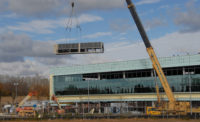When the Balsan Group of Johnstone Supply purchased space in Waldorf, Maryland for its seventh branch office, Jerry McPeak, the group’s Technical Service Advisor, was charged with designing the HVAC system. The project included total renovation of two adjoining 55 x 100 foot spaces: one for the office, showroom and training, and the other for warehousing the company’s residential HVAC products.
McPeak’s first priority was determining what utility services were available.
“I did an initial inspection. One of the interesting things I saw out back, and thought odd, was a gas meter tree and lots of propane tanks,” said McPeak. The space was previously used for manufacturing and was heated with infrared units.
McPeak needed more utility specifics to move forward. However, the utility company required him to submit an application for service before they would provide the information.
“It was early October and crunch time,” McPeak stated. “The utility company still hadn’t gotten back to us yet. So I had to look for a standard solution but couldn’t find anything.”
McPeak did discover the building was piped and metered for propane. “But we didn’t want to be beholden to the propane company, so we decided on a variable refrigerant flow (VRF) system of heat pumps for the warehouse side.”
AN ASSIST FROM SALES
McPeak was initially told the warehouse ceiling height was 28 feet and a dropped ceiling would be installed in the showroom/office area. However, final measurements and load calculations were significantly different — the warehouse ceiling was 20 feet high, and the showroom/office’s drop ceiling was cancelled.
Heat loss calculations called for a lot more equipment than budgeted.
Another configuration under consideration was air rotation using 20-foot diameter fans. But the fans brought floor-to-ceiling height down to 14 feet, not high enough clearance for a forklift driving around and accessing product in the warehouse racking.
While McPeak wrestled with mechanical options, Frank Delfis, Balsan Group’s top salesman, was meeting with Chris Uyrich, representative for L&R Associates, a Tjernlund Products rep firm.
Delfis reported the following conversion scenario to McPeak.
Uyrich said to Delfis: “Because you’re residentially oriented, you probably are not interested in this new destratification fan from Tjernlund. They’re specifically designed to direct stratified heated air residing at high ceilings down to occupied zones in industrial and commercial buildings, while only using 30 watts per fan.
“At that moment, a light bulb went off in Frank’s head. He knew I was in trouble with the new facility and told Chris: ‘I’ll tell Jerry he needs to talk to you.’”
McPeak called Uyrich the next day to get information about Tjernlund’s Destrat fan.
COMFORT WITH ROOM TO SPARE
There was enough data in the literature so McPeak could calculate how to deploy these fans and determine the maximum air rotation in the space. Because the mounted fans extend only 25 inches from the ceiling, over 18 feet of clearance was available for the forklift. Eight destratification fans were installed shortly thereafter. “Those fans solved my air rotation problem with the ceiling height being where it was,” noted McPeak.
The new branch’s HVAC system consists of two 150,000-Btu unit heaters and four destratification fans in the warehouse controlled by two speed controls, plus two 5-ton heat pumps in the showroom/office space.
They are a zoned VRF system, much like a “mini split on steroids.”
The Waldorf facility opened for business on December 28, 2018.
McPeak, a mechanical technology engineer who considers himself a numbers guy, said, “The numbers are panning out on these fans. In fact, before getting our VRF system up and running, the Destrat fans were so effective that they enabled us to maintain a comfortable temp during November and December using just a portable construction heater.”
What’s more, McPeak pointed out how the black-finished Destrat fans blend in perfectly with the black showroom/office area painted ceilings.
“They are an efficient and non-obtrusive way to direct conditioned air down where it belongs and to minimize equipment cost.”
Submitted by Tjernlund Products
Publication date: 6/3/2019
Want more HVAC industry news and information? Join The NEWS on Facebook, Twitter, and LinkedIn today!






